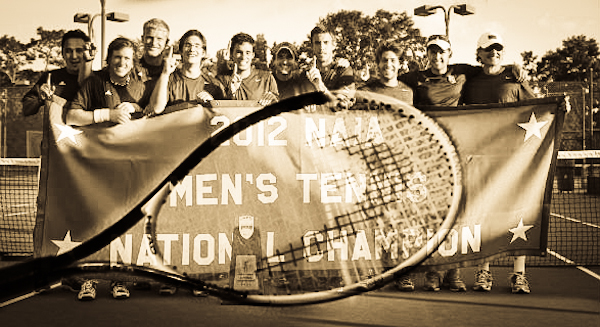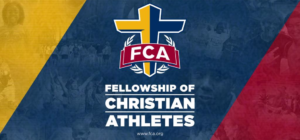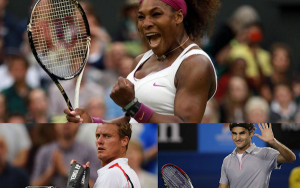Oklahoma Christian University isn’t cutting programs left and right, but there is no doubt: change is on the way.
The review, under the guidance of President John deSteiguer and his Team One cabinet, has made several decisions to discontinue or trim existing programs – the most recent and public of which is the cancellation of Oklahoma Christian’s NCAA Division II-ranked tennis program.
“The program review process is our opportunity to systematically and regularly go through everything we’re doing and determining, ‘is what we’re doing the things we ought to be doing?’” deSteiguer said. “There’s some stuff we’re doing that is absolutely great and world-changing, and there’s a lot of stuff we’re doing that’s good. But we got to be careful that we don’t sacrifice the best at the cost of doing the good; so there might be some good things that we need to pare back or stop doing.”
The Eagles won NAIA national titles in 2003 and 2012 under the leadership of head coach Kris Miller. Transitioning into Division II this season, the men’s tennis program debuted with a No. 10 national ranking, while the women were the top Heartland Conference team in the South Central Regional rankings at No. 9.
Team One consists of: deSteiguer, Executive Vice President Bill Goad, Vice President for Academic Affairs Scott LaMascus, Associate Vice President for Academic Affairs Don Drew, Vice President for Finance Jeff Bingham, Vice President of Advancement Kent Allen, Dean of Student Life Neil Arter, Vice President for Enrollment Management Risa Forrester and Vice President for Planned Giving and General Counsel Stephen Eck.
In the days leading up to spring break, Team One reached the decision to end the tennis program after the current season and informed Miller. The decision blindsided senior Martin Poboril and the rest of the Eagles.
“It was a huge surprise,” Poboril said. “We didn’t expect it because we all did well in our sport, on the court, and we did well in school. So we thought it would be fine, that we would still be here and playing.”
The coaching staff declined to comment.
Issues that took place the following week put a few individual players on disciplinary probation, leaving the team shorthanded and forced to cancel the rest of the season. Players who still have eligibility to play collegiately have the chance to transfer elsewhere, with the university’s promise to assist them in finding opportunities to compete. Team members who are in good standing and desire to stay at Oklahoma Christian to finish their education can do so; the university will honor their scholarships until they complete their degree.
“We know that doesn’t necessarily make it easier for them, but it does provide them additional opportunities,” deSteiguer said.
The ‘good standing’ stipulation grants the ability to deny Oklahoma Christian scholarships to students who act contrary to the university’s disciplinary code.
“It’d be ridiculous for the university to fund a scholarship for someone who was just going to be working against the university all the time,” Arter said. “And it’s actually true with all of the scholarships.”
Poboril graduates next fall from Oklahoma Christian and plans to play professionally for a year at home in the Czech Republic.
“I’m just happy that I got to meet the guys, the coach, the team, everybody,” Poboril said. “It was just a great experience, being here. It was fun, and I’m just sad it had to end like this.”
Factors in the decision to end the tennis programs include a lack of on-campus facilities, space available to build the program’s roster and funds from donations necessary to construct those larger buildings; these same characteristics are true of the golf program, with the exception of space for future roster expansion.
“I don’t know if there was ever a time where those two programs were put on the white board, and we compared this one versus that one,” deSteiguer said. “It was a difficult decision because of the individuals involved – any time you end a sport, that affects student athletes, and it affects coaches, and it affects families and that’s a hard, hard thing to do. In the case of tennis, it’s really unlikely that we will ever have facilities on campus that are befitting or adequate for a competitive tennis program.”
Director of Athletics Curtis Janz echoed deSteiguer’s sentiments about the decision, underlining that it was not a reflection on the program’s performance.
“We’ve had a lot of really, really good days in athletics,” Janz said. “This is not one of them . . . Kris Miller is an outstanding coach; Miller did everything he was asked to do, he has proven that he has quality student athletes. It’s hard to do these things, but the dropping of the tennis program is in no way an indictment of [Miller] or an indictment of the student athletes we have. It’s just that the university wanted to conduct the athletic department in a little different way.”
Janz also addressed the construction of the new athletic facilities and various improvements around campus – projects such as the new stadium for softball, bleachers for soccer and improvements to men’s and women’s locker rooms and bleachers in the gym.
“None of that money is budgeted money; all of that has been raised,” Janz said. “Your tuition dollars are not going to a new softball field. 100 percent of the softball field was donated. None of those things are taking anything away from the academic pursuits of the university.”
Not all the changes implemented are athletic, however. The review operates in a two-phase system, looking over everything non-academic first before moving on to the academic programs.
Other non-academic changes in place for the future include using just one hall director for the University House’s male and female wings, the removal of a budget line item dealing with strategic initiatives that now has separate funding, the consolidation of some faculty and staff printers and the discontinuation of a graduation ring program. The ring program by itself constituted a $40,000 expense, according to deSteiguer – a small percentage of the total $1.1 million the review has saved or made more cost efficient of their roughly $41 million annual budget.
“The decision not to continue the tennis program after this season is about a seven or eight percent piece of all the actions that we’re taking in regards to the institution,” deSteiguer said. “This is not a process of just cutting things. This is a process of doing some things differently and doing some new things that we haven’t done before as well.”
That being said, other non-academic adjustments instituted separately from the review cover faculty and staff positions. While some are retiring or choosing to go elsewhere, the administration decided that they will not fill those vacancies, eliminating six positions on the staff side. The money saved from their salaries contributes to the overall $1.1 million total.
A large force behind the reasoning for the tuition freeze, the now-constant program review and the subsequent termination of the tennis programs is the long-standing $5,000 cost gap per student.
“So student revenue is $15,000 per individual,” deSteiguer said. “The cost, the burden for operating the university per individual is $20,000, so for every student who comes, there is a $5,000 dollar loss for the university. There’s the gap … these are all ballpark figures.”
But, according to deSteiguer, the university operates on a balanced budget. Because the money is purely student-generated revenue, about $2,000 per student out of the gap is generated at Oklahoma Christian by other sources of income – mostly fundraising. But what about the remaining $3,000?
“It’s money that we should be putting into the physical plant of the campus, but we’re not,” deSteiguer said. “It’s essentially all the money that you need to be setting aside so you can make repairs and so you can also put a surplus together so that when a building catastrophically fails and has to be replaced, you have money available to do that. It’s important money, but in this year, it’s not urgent money. And that’s been the case for a number of years; it’s not urgent, so we’re not going to fund that, and that’s how we’ve been making up that gap. Accountants say it’s called deferred maintenance money.”
In trying to close that gap, the university is instituting measures such as the tuition freeze and program review to try and keep the schooling affordable, while still bringing in more money to chip away at the roughly $10 million gap total.
The program review doesn’t just take away; some measurements working their way through the academic approval process are a master’s of accountancy program, potential overhauls to chapel, the availability of an accounting track with a focus on actuarial sciences and engineering program adjustments to make them more marketable to Tinker Air Force Base and their surrounding businesses.
Informal discussions have also arisen addressing the possibility of adding women’s volleyball and swimming as sports in the future. While administration has debated the pros and cons of instituting these programs, ranging from bringing in local high school student athletes to questions of facilities, deSteiguer admits they are not prepared for them right now. Potential influences to the decision are possible adjustments to the gym, as well as the fact that Edmond is building a competition-grade swim facility five miles north of campus, with a scheduled completion date of the end of this year.
In the end, Arter suggests, the program review is simply a herald of change as Oklahoma Christian begins a period of thorough introspection to determine what it truly needs.
“We’re looking at all of those things – that’s what happens when you really start getting serious about program review, is everything is on the table,” Arter said. “Everything comes into play.”

















Be First to Comment